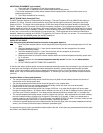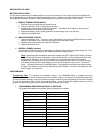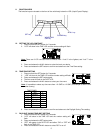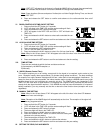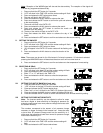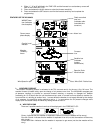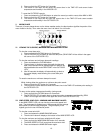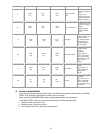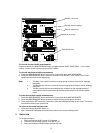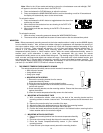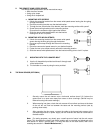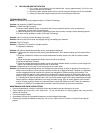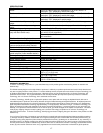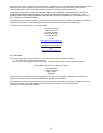16
III. THE INDOOR WEATHER STATION
1) Fix a screw (not included) into the desired wall, leaving approximately 3/16 of an inch
(5mm) extended from the wall.
2) Place the indoor weather station onto the screw using the hanging hole on the backside.
3) Gently pull the indoor weather station down to lock the screw into place.
TROUBLESHOOTING
NOTE: For problems not solved, please contact La Crosse Technology.
Problem: No reception of WWVB time signal.
Solution: 1) Wait overnight for signal.
2) Be sure indoor weather station is at least 6 feet from any electrical devices, such as televisions,
computers, or other radio-controlled clocks.
3) Remove batteries for five minutes, reinsert and leave the unit alone overnight without pressing buttons.
4) If there are still problems, contact La Crosse Technology.
Problem: Hour is incorrect (minute and date are correct).
Solution: Be sure correct time zone and daylight saving time settings are selected.
Problem: The LCD is faint.
Solution: 1) Set the LCD contrast to a higher number.
2) Replace the batteries
Problem: No outdoor temperature/humidity and/or wind speed is displayed.
Solution: 1) Disconnect the cable from the remote wind speed sensor, then reinsert making sure the cable clicks in
place.
2) Remove all batteries, reinsert into remote temperature/humidity sensor first, then the indoor weather
station.
3) Place the remote temperature/humidity sensor closer to the display.
4) Be sure all batteries are fresh.
5) Place the remote temperature/humidity sensor and indoor weather station in position so the straight-line
signal is not passing through more than two or three walls.
Problem: Temperatures do not match if units are placed next to each other.
Solution: Each temperature/humidity sensor is manufactured to be accurate to within 2 degree plus or minus and
under normal conditions, so two sensors could be as much as 4 degrees different. However, the difference
can be exaggerated further because the sensors are designed for different working environments. The
indoor temperature sensor is less responsive to ambient air currents because of the shielding effect of the
display's case. In addition, the case can act as a heat sink to absorb and store heat from external sources
(i.e. handling of the case or radiant heat). Also, the much greater range of the remote temperature/humidity
sensor requires a different calibration curve than the indoor range. Error is usually greater at the extreme
ends of a range, making it harder to compare different ranges with different curves. Under non-laboratory
conditions, it is difficult to compensate for the above factors and obtain an accurate comparison.
MAINTENANCE AND CARE INSTRUCTIONS
• Extreme temperatures, vibration, and shock should be avoided to prevent damage to the units.
• Clean displays and units with a soft, damp cloth. Do not use solvents or scouring agents; they may mark the
displays and casings.
• Do not submerge in water.
• Immediately remove all low powered batteries to avoid leakage and damage.
• Opening the casings invalidates the warranty. Do not try to repair the unit. Contact La Crosse Technology for
repairs.



